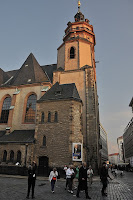We went to the Stasi Museum next. "Stasi" is a contraction of Staatssicherheit, or State Security -- the secret police. The museum is in the building that from 1950 to 1989 was the regional headquarters of the Staatssicherheit for the Leipzig area. The door is kept open now, as a contrast with the secrecy of Communist times. The sign says that the citizenry occupied the building during the Monday demonstration of December 4, 1989.
Our guide is on the museum staff now, but in 1989 she was a direct participant in the demonstrations that preceded the fall of Communism in East Germany.
The picture is of the front steps of the building (see above), covered with hundreds of candles during one of the demonstrations.
"Freedom for the 10 detainees."
Gabriel acted as translator. Here we see a video of a peaceful demonstration.
A combination of photo-mural and actual construction, showing the fence (not wall) that separated East and West Germany before 1989. In Berlin, it was a wall. In the countryside, it was a fence with barbed wire and obstacles to prevent vehicles from approaching the fence.
A poster calling for a civilian service alternative to military conscription. I expect that this idea wasn't too popular with the authorities.
Implements of destruction. There were no copiers in East Germany, and printing presses were tightly controlled and must be registered with the authorities. Churches had small printing machines like this one, which they used for Sunday bulletins and other church work. Some of them were also used to produce underground publications like this one. Die Mücke means The Mosquito. Everything having to do with distributing quantities of printed paper was controlled. It was impossible to buy paper in bulk without having to answer pointed questions.
Elections were something of a joke. On the TV monitor, the news presenter is announcing that the Communist's slate of candidates has received 97.3% of the vote. One didn't vote for individual candidates, just for a slate hand-picked by the party leaders. The ballot only listed the one slate, so there wasn't any real choice. There were voting booths with curtains, so that one could mark a ballot in privacy, but their use was discouraged. A voter was supposed to take a ballot and simply deposit it in the ballot box without marking it. This was called "voting freely and openly." The names of those who used the voting booths were recorded by the police and reported to the Stasi. Even so, one person was emphatic on this ballot: he or she has scratched out all the names on the official party slate, and written NEIN! on the top.
Our guide was the artist who drew the cover of this underground pamphlet. It was about pollution of the river that was killing off the fish. Criticizing the government over environmental pollution was just as heinous a crime as criticizing it politically.
The beginning of the end. Peaceful demonstrations had been held each Monday evening for some time, pressing for peace, human rights, environmental protection, freedom to travel, and democratic elections. In early October 1989, the demonstrations grew dramatically in size from Monday to Monday, with 90,000 participating on October 9. The security forces, lacking explicit orders from East Berlin or Moscow, declined to provoke an incident that might cause a massacre. According to Wikipedia, the demonstrations continued to grow to 320,000 over the next few weeks. Leipzig's population is only about 500,000. On November 9, the Berlin Wall came down, and Communism started unraveling rapidly.
The title on the left-hand panel says "Beginning of October 1989 -- DDR-wide Mass Protests". On the right, the title says "Day of Decision" or "Day of Judgment".
"We are not rowdies. We are the people." The protesters chanted Wir sind das Volk as they marched.
This one needs no translation.
The visit to the museum was moving, not least because we heard first-hand from someone who, with other members of her family, was a participant in the events.
Back on the street, the Goths were still out in force.
We had a wonderful dinner at Auerbachs Keller. Tonight's special was Wildschweinbraten, but I doubt any of us had that. Apologies for the odd color of these pictures, but I've been unable to adjust them to look natural. The lighting in the restaurant must have been unusual.
The sun was setting as we left, making the buildings glow as we walked back to the railway station. Goths were still wandering the streets.
Supposedly, rubbing one's hands on these handles at the proper speed will cause jets of water to shoot up. Didn't happen for us, though.
A whimsical cake in a shop window.
Church towers in the sunset.
An unusual mural.
Back at the station, we waited for our fancy Inter-City Express train to arrive. "Hbf" is Hauptbahnhof, or Central Railway Station.
A very interesting day in Leipzig. Back to Dresden for the night, and tomorrow morning the train to Berlin.
Subscribe to:
Post Comments (Atom)







































No comments:
Post a Comment